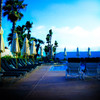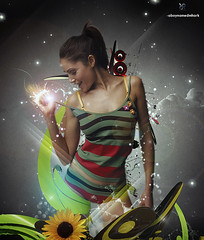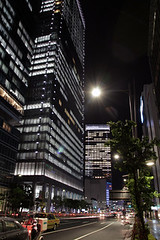The Triumph of Divine Providence by Pietro da Cortona was the subject of my MA thesis in New Zealand, submitted to the University of Auckland in August 2006. Below is the story of the decoration with appropriate explanation, extrapolated by my thesis.
The decoration
The decoration of the huge ceiling of this majestic hall was intended to celebrate the triumph of the Barberini family, personified in Maffeo Barberini’s ascent to the papal throne in 1623, and the family’s spiritual and temporal power. The imposing fresco depicts The Triumph of Divine Providence and the fulfilment of her ends under the papacy of Pope Urban VIII.
Cortona with his trusted assistants, Romanelli, Ubaldini and Giovanni Maria Bottalla (Savona 1613/Milan 1644), painted the vault, using the big scaffolding which had to be rearranged from time to time throughout the execution of the work. There is no documentation that can establish exactly what duty the assistants were responsible for, whether they worked on the decorations only or also the figures, whether they were free to paint their own creations or whether they painted only secondary details. In preparation, Cortona with all his assistants almost certainly discussed themes and choices until they converged on the same language and style, the fruit of their shared experience. The result of this representation is described in this way by Ludwig von Pastor, in The History of the Popes (originally printed in 1855):
In the centre the figure of Divine Providence is seen enthroned in heavenly glory and resplendent with dazzling light; Immortality floating upwards holds a crown of stars with which to crown it; at its behest winged genii carry towards heaven the tiara, Peter’s keys, and poet’s laurel wreath shaped like a shield and bearing the Barberini bees. The representations of the longitudinal and transverse sides are likewise subordinate to the main group. The former show Minerva casting down the Giants, viz. Heresy and Unbelief; at the bidding of Justice, Hercules slays the harpies whilst Plenty pours out its cornucopia over the earth; human Wisdom and its spring, religion, overcome the passions of the body; Papal Sovereignty, guided by Prudence, fetters war and holds it in check by the creation of an armed force (Vulcan’s smithy).
A large-scale project like the vault had to follow a standard modus operandi, which was used by Cortona and many other artists. Unfortunately there is neither trace nor mention among the Barberini documents of a possible large-scale outline on canvas created by Cortona and showing the entire ornamentation of the ceiling or a single section. This is very unusual, as Cortona would have needed some way to show his design to his patron.
Only a few drawings have survived in the case of the Barberini ceiling and these are scattered in museums all over the world. Amongst them we can mention the clypeus with the Heroism of Mucius Scaevola. The iconographic subject here is the theme of Fortitude, with the representation of the lion. Between the final execution and this drawing there are some differences, such as the introduction of a mask on top of the octagonal episodes that are not evident in the fresco. Another interesting drawing is in Florence. The subjects represented here are: the Cyclops forging arms; Peace enthroned, and Furor. This drawing is mentioned only in the Santarelli collection as a drawing made by Cortona. Making a comparison between this drawing and the fresco decoration we can consider the drawing as a copy of the original episode painted by Cortona, because it is meticulously copied from the original.
Fortunately the various types of surviving drawings – sketches, details and overall views – confirm that Cortona began by roughing out his ideas, intended to provide inspiration and act as a reference during the actual painting stage, but they were not, strictly speaking, technical apparatus. In contrast, the full-scale cartoons, which unfortunately do not exist or have disappeared, were produced to play a different role: they were placed on top of the plaster like a kind of stencil for the transfer of various sections of the decoration. A wooden stylus was used to trace the outlines onto the wet plaster through the card, which is more porous than paper. The cartoons were not necessary for purely linear elements such as architectural details, cornices and trimmings, and the lines were directly engraved into the intonaco. As a rule, cartoons and sketches, which were often only considered in terms of their importance for the final result, did not receive appropriate attention. When used up on the scaffolding to assist the artist in reproducing the lines in their painting, they could get stained or torn, thus they did not survive the work for which they had been created.
The drawings were not the only source utilised for the execution of a fresco decoration. For Cortona’s planning stage, it was necessary to decide on the subject to illustrate on the vault. In the past, for example, it was the custom to celebrate the family ancestors, along with ancient personages and heroes, such as Vasari’s Sala dei Cento Giorni in the Palazzo della Cancelleria. However, during the seventeenth century the new families like the Barberini, not having a proud history to tell, decided to include only present family events with representations of mythological, biblical subjects and/or allegorical figures in their personal residences.
The programme of the vault frescoed by Cortona originated in the cultured circles of the Barberini family and of the erudite Pope, author of several poems, collector, and the foremost patron of arts during his long pontificate, as discussed in chapter one. Urban VIII lived in splendour with his family in the palace, surrounding himself with a court of intellectuals, with whom he undoubtedly developed the ceiling project.
The consultations amongst the members of the Barberini circle probably gave birth to the fresco project, drawn up by a person very close to the Pope, the Tuscan Francesco Bracciolini (1566-1645), who wrote a little book on the election of Urban VIII. Scott summarises Bracciolini’s book, L’Elettione di Papa Urbano VIII (1628), where the main focus is the election of the Pope. Scott summarises Bracciolini’s book with these words:
Anxious over the possible election of Maffeo Barberini to the papacy, the vices, with Falsity as their leader, from themselves into seven groups and occupy the Seven Hills of Rome, while Truth and the other virtues repair Castelgandolfo. After an initial setback, the vices rally a Fury wounds Justice with an arrow. Self-Interest challenges each of the virtues to duel, and, as the vices gain the upper hand, Justice suggests that the virtues abandon the earth and return to heaven. Charity and Justice then climb up to the heaven in search of help. At the threshold of paradise they encounter Divine Providence, who ensures them that God will provide for the proper resolution of the conflict. Then word arrives that the life of Self-Interest is in danger because of excessive drinking. Charity descends, out of the pity, to aid the stricken vice. Meanwhile, Ecclesia, in supplication at the foot of the throne of the Eternal, receives assurance that the current crisis will be resolve by the election of Maffeo Barberini to the papacy. Astrea descends in order to learn about the new pontiff from the virtues and hears from Mercury and Urania about the origin of the Barberini family. Reason of State opposes the election of Maffeo, using the now revived Self-Interest to spread discord among the cardinals. Religion slays Self-Interest, but then Sickness is dispatched against the cardinals. Maffeo’s guardian angel predicts that he will be elected. Making a final stand, Pluto himself sends Envy and Error into the conclave. Maffeo immediately vanquishes Envy, but Error manages to carry off on of the ballots. As Maffeo calls for another vote, a Virgin enters the conclave and banishes Error. Maffeo is elected by anonymous vote.
The poem is very long and intricate, even so can be considered the main inspirational source, because it is the only published source prior to the execution of the ceiling. Bracciolini is mentioned for the first time in a letter written by Domenichino to Francesco Angeloni in 1640, where Domenichino showed interest in the new ceiling painted by Cortona:
I have been delighted in learning about the newly unveiled painting by Cortona… I would be curious only to know the means of invention of the stories represented; it seems I have heard that it is a fantasy of Bracciolini’s on the praises of the pope. According to the little information given to me, I doubt that it is wanting, and it would appear to be more suitable for a secular prince.
Even if Bracciolini is mentioned in the painter Domenichino’s letter, Scott does not believe Bracciolini was an inspiration for Cortona, because he did not provide a written programme. He considers, instead, the Dichiaratione by Mattia Rosichino (Rome, 1640) as the “definitive program of the painting”, because it was written under the suggestion of Bracciolini, as an early source of information, after the ceiling was finished. In fact, Rosichino’s short pamphlet was addressed to the visitors of the palace, who could in this way identify the figures and the general meaning of the scenes without difficulty. Rosichino used these words:
Rosichino to the Spectators: As one gazes at the paintings made by Signor Pietro Berrettini da Cortona on the vault of the hall of the Signori Barberini, he understands that they are among those things that above all others delight the eyes of mortals. But because such pleasure extends only to the form and disposition of the colours and figures, the observers, remaining deprived of the enjoyment of understanding the meaning, continually turned to me, since I am always around here (as required by my position), and asked me to explain the paintings to them. They perhaps thought that because I am always present where these paintings are located that I even knew them intrinsically. Forced therefore by these curious people, I went on this matter to someone who is a poet, or at least a philosopher, and told him of the need I had of his erudition because of the curiosity of others. Out of compassion he shared it with me and made me knowledgeable of the explanation I sought. But fearing the defect of a memory not too accustomed to retaining things so speculative and exalted, I decided to have them printed and to present them to you spectators in order to free myself from that nuisance and satisfy your questions. I beg of you only that, if I do not tell those matters exactly as they were taught to me, you excuse my poor memory and accept in compensation the good will I have had and have to serve you.
The writer, Rosichino, thinks it is more appropriate to explain the meaning of the fresco in a pamphlet, but this programme was composed after the ceiling was completed so can not be used as the main planning source. Rosichino describes the ceiling in this way:
Declaration of the Paintings: The vault of the great hall of the Barberini is divided and painted in five parts. In the centre part is Divine Providence, who sits on a cloud, ornamented with splendours, with a sceptre, and in the act of commanding the present and the future. And therefore Time, who in the form of Saturn devours his own children, is held with the Fates under her. Around her are Justice, Mercy, Eternity, Truth, Purity, Beauty, and others who seem to want to obey her. But above all others Immortality appears to execute the commands, moving with the crown of stars to crown the arms of Urban VIII Supreme Pontiff. The papal arms are surrounded by two great branches of laurel, which rendered together create the image of a shield supported by Faith and Hope at the sides and by Charity at the bottom, with the three bees flying inside these. Above are Religion with the keys and Rome with the Papal Tiara, and a child with a garland also of laurel – sign of poetic excellence – is playing there nearby. In the second part, that is, in the front of the hall toward the garden, is the image of Minerva, denoting Wisdom, who overthrows with her lance the Giants who are seen hurled down and weighed down by those mountains they themselves has amassed in order to challenge Heaven. Here is expressed the defence of ecclesiastical things. Opposite, the third part represents the temporal government. Those two youths who seem to be coming from above signify, first, Authority with the consular fasces, and, second, Abundance with the cornucopia. Kneeling in front of these are all kinds of people, such as old men, children, and widows, and many others who expect gifts from them. There, by Hercules, who casts out the Harpies, is meant the chastisement of kings. Beneath this part, in the feigned bas-relief ornament is the club of this same Hercules, which sprouts – a device of the Barberini family. On the right as you enter in the fourth part; here one sees Knowledge uplifted by Divine Assistance, who is denoted in the young man who is agile with his wings. Knowledge holds a book in one hand for the knowledge of things and, in the other, a flame to symbolize that it is her nature to uplift herself. She is also accompanied by Piety toward God, expressed in the modestly dressed and venerable woman who has a tripod with fire inside ready for the sacrifice. Beneath Knowledge are gluttony and lasciviousness. The first is represented by Silenus, for whom fauns and satyrs pour wine in the great cup he holds in his hand. Bacchantes, with young Bacchus in their lap avidly devouring a bunch of grapes, represent the bad upbringing of youths. Lasciviousness is embodied in a reclining woman next to whom are discerned some chaste and lewd cupids. But the chaste ones, urged on by Chastity, personified by the woman dressed in white with the lily in hand, drive away the lewd ones with torches so that she who is lying seems frightened by them. Not far from here there is painted a fountain with women around it, one of whom is adorning herself in order to denote the vanity of worldly pleasures. The device perceived here is the plough pulled by two bees with a third who steers it and is guiding them with a whip. Opposite this, one sees the last section. In this, Dignity holds in the right hand the caduceus and in the left a key. Prudence reverently holds up a mirror to her, and Power, delegated with a key and a written sheet, is nearby but in the act of departing. Then next is Fame. And Peace with the olive branch closes the door to the Temple of Janus, outside of which one sees Furor tied with his torches on top of many armaments. He seems in appearance to struggle, except that Gentleness holds him still with a noose. There is also Fury with her torch who, thrown down, appears deprived of strength. Not far away is the forge of Vulcan where several Cyclops exert themselves to make weapons, alluding to the preparedness which is necessary for the defence of the provinces even in peace time. Here the rising sun is the device. Besides this there are four medallions in the four corners of this vault. In these there are expressed the four virtues – Temperance, Fortitude, Justice, and Prudence. Temperance: with Scipio the Younger sent back untarnished to her Saguntine spouse the young maid he had captured as his booty. Fortitude: with Mucius Scaevola when he burned his right hand, having erred killing a civilian instead of King Porsenna. Justice: with Titus Manlius when he even happily had beheaded his son who had violated his prohibition. Prudence: with the story of Fabius Maximus when restraining himself in his quarters held Hannibal in check. Under the medallions one sees portrayed a unicorn to represent Temperance, a lion for Fortitude, a hippogriff for Justice, and some bears for Prudence because they develop their offspring slowly with time.
The description is short, but exhaustive, without moral and complicated language. The author identifies the figures, describes their action and states the meanings. It is addressed to the visitors of the palace, who in this way can enjoy the Cortona’s fresco ceiling.
But Rosichino’s pamphlet is not the only one composed after the ceiling was completed. There are other longer sources, such as the anonymous Il Pellegrino ò vero la Dichiarazione delle Pitture della Sala Barberina (around 1642), more sophisticated and with philosophical meaning, and therefore not accessible to a general audience but only to erudite people like the educated sphere of the Barberini family. Almost certainly manuscript circulated amongst the members of the Barberini circles and today it is conserved between the other family documents in the Vatican Archive. This Codex Barberini Latino 4335 (Il Pellegrino) is a description of the fresco, contained in a moral commentary and ornamented with poetic conceits.
The manuscript takes the form of a conversation between a young traveller and an elderly palace guide, who wants to instruct the pilgrim on the allegory and the sense of the figures. In his explanation the author uses analogies, which creates parallels between the nine stories represented in the vault and the nine Muses, described by Ripa in his book, Iconologia. The immediate consequence is a connection between poetry and art, from which emerges the famous verse created by Horace’s: ut pictura poesis. First, the guide wants to introduce the more complex and emblematic part of the vault, the central zone, where the Triumph of the Divine Providence is represented. Here the author mentions the presence of God manifested in the figure of Providence, Fame, Theological Love and the light they share. The Pope has power received from God, through which he governs the Catholic Church. With God’s help, he can defend the Catholic population from external circumstances and provide them with love and knowledge in spiritual matters. By doing this the Pope will be remembered forever. The source reports these words:
… But we have still to consider – paying particular care – how these Barberini bees, their laurel branches, the Virtues who hold them, the assistant who help, Heaven itself, which favours them, Time, Movement, the Fates and indeed everything that is shown in that uppermost cove of the Salone, how all of this depends (and after all what does not?) upon Divine Providence, and is known thanks to her and not by earthly means. Because Divine Providence is nothing less than God Himself, governing all things, turning them upside down, starting, finishing, disposing, rearranging without paying heed to a single soul. So: the main narrative that we are admiring and making an effort to understand, is nothing else but God, and because He is like an infinite and incomprehensible ocean whose depths are unsounded and whose farthest shore are unknown, we expend our efforts in vain, trying to hoist the little sails of our human intellects...
Moreover, these sources do not formulate the original programme of the ceiling, because they were written after the ceiling was completed. For the execution of the Triumph of the Divine Providence, Cortona probably used Bracciolini as a basic source, Ripa’s Iconologia, his previous experience, his trip to Florence and northern Italy, plus continued consultations amongst other artists, advisers and patrons. The several drawings have various subjects and are related to specific personages represented in the fresco. However, we do not possess a drawing where the entire vault is represented. This suggests that the artist desires to be free in his execution with no limitations or restrictions, with the possibility to change parts of the fresco and produce something else.
Considering the complexity of the ceiling and its iconography, presented in extensive and detailed manner by Scott, I will give an overview of the ceiling. Later I will focus my attention on the several restoration campaigns and the result of the most recent restoration, which is going to follow in the next chapter. The main scene is the central one, as expressed by Rosichino in 1640 and by the author of Il Pellegrino (around 1642), whose subject gives the title to the entire fresco. Rosichino does not say much about Divine Providence. She “sits on a cloud, ornamented with splendours, with a sceptre, and in the act of commanding the present and the future”. Instead the anonymous author of Il Pellegrino praises Divine Providence, describing her in this way:
She was intelligently represented by the artist seated upon a cloud to demonstrate her decisiveness with regard to this lucid genealogy. And the cloud which forms her support symbolises the hidden way by which God acts through second causes in his provision for us, the effects of which we cannot predict, only recognize them afterward when the events are over. Look how Divine Providence sits, actually giving the order of command, holding her sceptre, the sign of her majesty in one hand, while around her head glows a very bright light contrasting with the blue of the sky.
The head surrounded by a halo of light underlines her divine nature, thus justifying Urban VIII’s divine election to the pontificate with God’s intercession. The “lucid genealogy” symbolises the connection between the figure of Aeneas and the Barberini family. Aeneas arrived to Latium with his parents and founded the “Roman kingdom” after Troy was destroyed. The Pope’s family left Florence for Rome, where he was glorified as “Supreme Pontiff – just as the heirs of Aeneas founded the Roman empire on the soil of Latium”.
Divine Providence is surrounded by other Virtues, who move at her command, because she is the one who rules over the present and the future. Chronos, or Time, depicted naked and mighty, with great feathered wings, in the act of devouring his children. He is below Providence and represents the present. On his right the Three Fates, Clotho, Lachesis and Atropos, holding the thread of human existence, are a further reference to the fleeting nature of time and its incessant passing. To the left of Providence and moving at her command is Glory, wrapped in fluttering drapery and holding a crown of bright stars above the great Barberini coat of arms depicted in the centre of the vault, thus crowning it with eternal glory. This ingenious apparatus glorifies the Pope through the symbol of his house, three bees, painted here in a giant monumental form, set within an unusual escutcheon formed by laurel branches, symbolising not only triumph but also poetic value, a reference to one of Urban VIII’s many virtues. Holding up this unusual shield are the three Theological Virtues: Faith, dressed in white, Charity in red and Hope in green. On the left, at the summit of the coat of arms, is Religion holding two keys, one for divine authority, the other for temporal authority; and on the right, powerful and monumental Rome hands the papal tiara to Urban.
On the short side above the windows, the scene represents the Triumph of Peace and Justice . In the top right section is the solemn figure of Justice, distinguished by her bundle of rods and her two-edged hatchet, thus connected by the artist with the more antique Roman justice. She is accompanied by Abundance, bearing fruit and grain, without which humanity could not live in prosperity and happiness. On the left is Hercules, the hero of legend, depicted in the act of swinging his club at the Harpies, fierce monstrous creatures personifying evil, thus alluding to the victory of virtue over vice. One of the harpies seems to plummet towards the spectator tumbling towards the space near to the corner of the she-bears.
The section on the long side opposite the entrance represents the good government of the Barberini during the Triumph of Religion and Spirituality. Knowledge is depicted in the centre with Divine Assistance. These figures together symbolise the Pope’s knowledge of spiritual matters illustrated along the same panel on the left with the portrayal of Lust, a provocative female figure scantily dressed in white drapes and a red mantle billowing out behind her. The backdrop is formed by a lovely garden and a fountain around which a group of young maidens cluster, one of whom is intent upon combing her hair, thus referring to the vanity of worldly things. On the right side of the same panel is the fat Silenus sprawling drunkenly and surrounded by Fauns and Satyrs pouring wine into a goblet, and scantily-dressed Bacchantes wearing veils and leopard skins are holding the child Bacchus in their arms. The Bacchante facing away from us, her tousled hair pulled into a knot on the nape of her neck, is a genial invention of the artist and an example of great female beauty which he would represent on many other occasions.
The section on the short side opposite the windows symbolises the victory of Intelligence over brute Force. The protagonist is Minerva, a powerful figure in flight, rushing through the scenes, armed with a lance and shield. The goddess of sciences and wisdom, Minerva, is shown trouncing Gaea’s colossal sons who attempted to overthrow the gods and who represent primitive brutality. The artist depicts their muscular entwined limbs, huge hands and fierce, wild faces. The marked foreshortening of this scene accentuates the rushing fall of the Giants towards the viewer. Giulio Romano’s splendid fresco decoration for the Sala dei Giganti in Palazzo Te in Mantua (around 1531) was probably a good inspiration for Cortona, who saw that during his journey north.
The subject of the section on the long side to the left of the entrance represents the beneficial effects of the government and policies expressed by the papacy of Urban VIII. The centre is dominated by the figure of Dignity, sometimes called Peace, holding in her left hand a key and in her right hand a caduceus, or winged staff formed by an entwining serpent, the attribute of Mercury and symbol of peace. By her side, almost in the guise of advisor, stands Prudence, wearing red and white and holding out a mirror, her symbol, and with her back to us, Delegated Power, holding a key and a piece of writing, ready to depart at her orders. Near to the Delegated Power area is winged Fame blowing a horn to proclaim the glory of the Barberini family. Peace bears an olive branch and runs close to the door to the Temple of Janus, as a sign of new times of peace and prosperity which will give rise to art and a quite life. To underline this concept, the artist placed the figure of Fury in the right-hand section of the panel. This menacing naked figure lying on a heap of broken weapons is shown struggling to free himself from the chains and ropes with which he has been bound by Docility. At his feet, a now weakened Fury armed with a torch tries ineffectively to free him, representing the devastating effects and misery produced by war. Completing the scene, on the opposite side, is the workshop of Vulcan who is depicted forging weapons together with some Cyclops, recognisable by the single eye in the middle of their foreheads.
Groups of four huge sculptures are painted to correspond to the elaborate trabeations at the four corners of the cornice as though to support and confine the complex corner decorations. Above the two nudes painted in profile the sinuous bodies of the Tritons wind around the octagonal clypeus painted in fake bronze. They depict a famous episode from Roman history, reported in the Ab Urbe Condita of Livy, alluding to the civic and the moral virtues passed down from the antique world to the Barberini house. Depicted below each clypeus, almost at the bottom edge of the decoration, is an animal whose allegorical meaning reflects the virtue represented above.
In the corner next to the entrance we find the figure of the hippogriff, symbol of perspicacity, in correspondence with the clypeus representing the Justice of Consul Manlius. Further to the right we find two she-bears, symbol of rationality, below the octagon with the Providence of Fabius Maximus. In the other corner there is the unicorn, symbol of purity, linked to the Temperance of Scipio. Finally, the lion, symbol of fortitude, is by the clypeus with the Heroism of Mucius Scaevola.
Considering the entire ceiling, the historian Passeri describes that with words of praise, as if “it seems painted in the space of a single day”. The most surprising characteristic of the work is the supreme unity of the fresco work that permits us to take in the multitude of scenes and their variety in a single view, as if they had been created all together and not during the long period that was actually required to paint them (1632-1639). The quality of the fresco creates an overwhelming sensation in the viewer, who desires to see, appreciate and gradually scan the work in order to identify the sequence of scenes.
The big fresco is conceived as a single epic narration even though the artist decided to use a huge amount of images to fill the entire vault, painting various scenes separated in the several panels of the ceiling. The variety of the scenes which overlap and run into the vault forces the observer to move back and forth across the entire ceiling to follow the sequence of images, which are linked together, creating a constant relationship with the surroundings. For example, Science and Winged Genius, who turn their attention to the figures in the centre panel, or their neighbours Providence, and Religion on her left, refer to the three theological virtues, Faith, Hope and Charity, painted just above her; Dignity seems to be directly linked to Immortality who looms above her in the central section of the vault. And, though they occupy separate panels, Fury and Giants are depicted in all their savage brutality on either side of the corner ornament distinguished by the lion. The image of Justice bearing her rods on her shoulder is echoed by the monochrome putti in the corner with the hippogriff who are struggling to hold an enormous bundle of rods. The effect is that of a recreation of reality that captivates the viewer, involving their senses and provoking their wonder. Considered from this point of view the Barberini ceiling has no precedent in the history of art and represents the blooming of a new language. The decoration of the vault confirms Cortona’s position as a great history painter. In the Rome of his days this commission conferred Cortona supremacy, which would accompany him throughout his career as a painter.








































